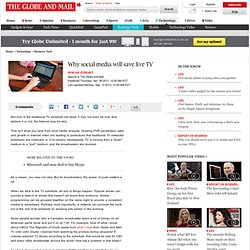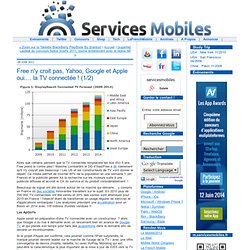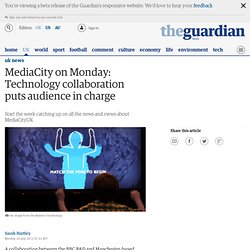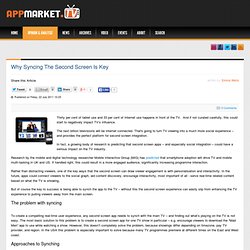

State of the TV Sector / Deloitte. SnappyTV for iPhone, iPod touch, and iPad on the iTunes App Store. Why social media will save live TV. Not only is the traditional TV schedule not dead, it may not even be sick.

And believe it or not, the Internet may be why. That isn't what you hear from most media analysts. Growing PVR penetration rates and growth in Internet video are leading to predictions that traditional TV networks' schedules are irrelevant. In 21st century mediaspeak, TV is moving from a "push" medium to a "pull" medium, and the broadcasters are doomed. As a viewer, you may not care. When we stick to the TV schedule, all sort of things happen. Some people wonder why a Canadian broadcaster spent a lot of money on an American game show and put it on at 7:30. As I have discussed in previous columns, PVRs aren't as big of a factor as you might think. Aha…but what about demographics, you cry. True. While there are technological and demographic forces moving viewers away from the schedule, there is another force moving them back toward simultaneous linear TV consumption.
I was talking with Hubert T. GOAB. A TV Experience Concept / Prologue. How To Curate Your TV Watching. Insights into innovation in social TV. Why has Facebook spent a colossal $19 billion to buy US-based mobile messaging app WhatsApp?

Here are the six reasons the deal makes strategic sense. 1) The target is reaching 5.6 billion smartphone users by 2019 In the prepared statement for the acquisition, Facebook founder and CEO Mark Zuckerberg said, “WhatsApp is on a path to connect one billion people. The services that reach that milestone are all incredibly valuable.” This is undeniably true, in the short term. At this growth rate, it could reach the one billion MAU mark in around 24 months, by early 2016 (allowing for some new users not becoming MAUs). Zuckerberg himself takes the more conservative view, at least for public consumption, that WhatsApp will gain one billion MAUs in the next five years. But the ultimate target is significantly larger.
Miso branches out with social TV app gallery. Netflix planning ‘extensive’ Facebook integration. TV is going Social and Interactive; What about Radio? Free n'y croit pas, Yahoo, Google et Apple oui.... la TV connectée ! (1/2) Alors que certains pensent que la TV connectée remplacera les box d'ici 5 ans, Free prend le contre pied !

Maxime Lombardini le DG d’Iliad/Free a dit clairement qu'il n'y croyait pas beaucoup ! Les US et les constructeurs de TV vont donner le départ. Ce média permet de toucher 80% de la population en une semaine !! (en France) et la publicité génère X4 la recherche sur les moteurs suite à une publicité diffusée et accroit le CA du service et du produit considérablement ! Beaucoup de signal ont été donné autour de ce marché qui démarre... y compris en France où des sociétés innovantes travaillent sur le sujet.
Les ApGoYa Apple serait en préparation d'une TV connectée avec un constructeur ? Si le projet d'Apple est confirmé, cela pourrait comme l'iPad surprendre, la marque pourrait devenir leader sur le marché de l'usage de la TV ! MediaCity on Monday: Technology collaboration puts audience in charge. A collaboration between the BBC R&D and Manchester-based magneticNorth has resulted in a musical interactive project called Maestro which puts the audience in the role of conductor. ln this video, the technology can be seen in action with children able to conduct the BBC Philharmonic Orchestra during an installation event held as part of Manchester International Festival.

The Drum reports the way Maestro was developed using Microsoft Kinetic, a technology developed for the Xbox which senses motion and enables users to control and interact with the console without touching a controller. The Maestro lets the audience control the tempo and dynamic of the orchestra using nothing but their hands. Adam Todd, creative director at magneticNorth explained: "The Kinect allowed us to create something that children found natural to use, and as the complex technology at the core of Maestro is hidden away it makes the experience is even more magical. " Research and Development: Orchestrated Media - beyond second and third screen (II) Connect. USA Network rolls out second screen experience. Why Syncing The Second Screen Is Key. Why Syncing The Second Screen Is Key Details Published on Friday, 22 July 2011 10:25 Thirty per cent of tablet use and 33 per cent of Internet use happens in front of the TV.

And if not curated carefully, this could start to negatively impact TV’s influence. The next billion televisions will be internet connected. In fact, a growing body of research is predicting that second screen apps – and especially social integration – could have a serious impact on the TV industry. Research by the mobile and digital technology researcher Mobile Interactive Group (MIG) has predicted that smartphone adoption will drive TV and mobile multi-tasking in UK and US. Rather than distracting viewers, one of the key ways that the second screen can draw viewer engagement is with personalisation and interactivity. The problem with syncing To create a compelling real-time user experience, any second screen app needs to synch with the main TV – and finding out what’s playing on the TV is not easy. 1. 2. 3. 4. SOCIAL MEDIA + TV.